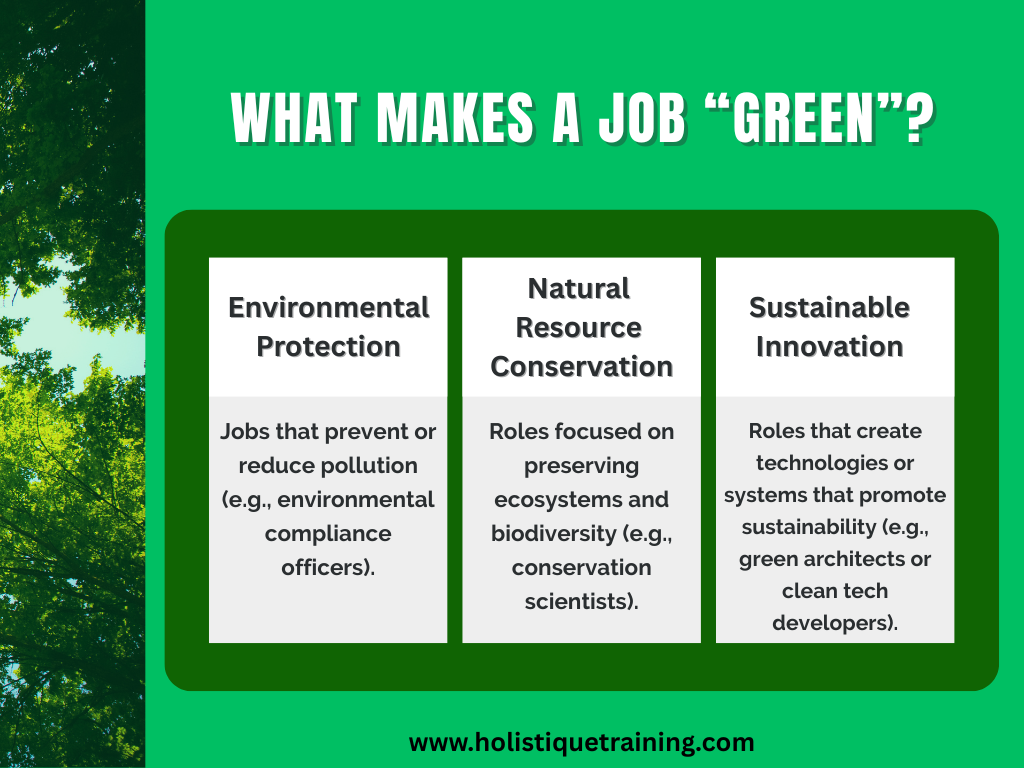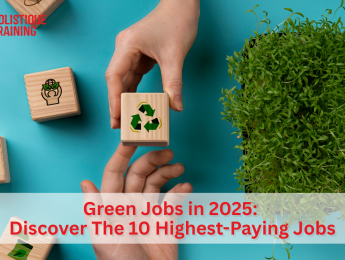- Table of Contents
- Introduction:
- What Makes a Job “Green” in 2025?
- Why Green Jobs Matter in 2025
- The Economic Impact of the Green Industry
- The 10 Highest-Paying Green Jobs in 2025
- 1. Renewable Energy Engineer
- 2. Sustainability Director
- 3. Environmental Lawyer
- 4. Wind Energy Project Manager
- 5. Green Building Architect
- 6. Climate Change Analyst
- 7. Solar Energy Consultant
- 8. Environmental Engineer
- 9. Sustainable Supply Chain Manager
- 10. Conservation Scientist
- Conclusion:
Introduction:
In recent years, the climate crisis has shifted from a distant concern to an urgent global reality. From rising sea levels and extreme weather events to increased pollution and biodiversity loss, the need for immediate action is more pressing than ever. This growing environmental awareness has pushed governments, industries, and individuals to seek solutions that reduce harm to the planet while creating economic opportunity. One of the most promising developments in this context is the rapid expansion of the green job market.
Green jobs are no longer niche roles confined to environmental NGOs or government-funded projects. They now span across sectors like energy, agriculture, transportation, architecture, and technology—driven by innovation, regulation, and consumer demand. Moreover, as sustainability becomes a business imperative, many of these roles offer not only social impact but also impressive salaries.
In this article, we will explore five major areas that highlight the growing importance of sustainability in the job market. First, we will define what makes a job “green” in 2025 and explain the criteria that set these roles apart. Then, we’ll examine why green jobs matter more than ever in today’s world. Next, we’ll look at the economic impact of the green industry and how it’s shaping global employment trends. The core of the article will present the 10 highest-paying green jobs in 2025, outlining their responsibilities, salary ranges, required skills, and environmental contributions. Finally, we’ll conclude with practical next steps for those interested in pursuing a green career path.
What Makes a Job “Green” in 2025?

The definition of a "green job" has evolved significantly over the past decade. In 2025, a green job refers to any role that directly or indirectly contributes to environmental sustainability, resource efficiency, and the reduction of greenhouse gas emissions. These jobs can span a wide range of industries—renewable energy, sustainable construction, clean transportation, environmental science, waste management, and more.
A key distinction of green jobs is that they aim to protect the environment while supporting economic growth. For example, roles like wind turbine technicians or solar engineers focus directly on clean energy production, replacing fossil fuel-based energy sources. On the other hand, urban planners who design walkable cities with green infrastructure or data analysts who optimize energy consumption in buildings also qualify, even if they are not working in an environmental organization per se.
What makes a job “green” isn’t just the employer’s mission—it’s the impact of the job itself. This can be broken down into three primary categories:
- Environmental Protection – Jobs that prevent or reduce pollution (e.g., environmental compliance officers).
- Natural Resource Conservation – Roles focused on preserving ecosystems and biodiversity (e.g., conservation scientists).
- Sustainable Innovation – Roles that create technologies or systems that promote sustainability (e.g., green architects or clean tech developers).
Moreover, in 2025, digital transformation plays a significant role in green jobs. Data-driven decision-making, artificial intelligence, and automation are being used to track, manage, and optimize sustainable practices. For instance, AI is used to monitor deforestation or detect leaks in water pipelines.
In summary, a green job in 2025 is not only about "what" the job is but also about "how" it is done. Any role that intentionally prioritizes sustainable methods, reduces environmental harm, and supports long-term ecological health can be part of the green workforce.
Why Green Jobs Matter in 2025
Green jobs are crucial in 2025 because they lie at the intersection of environmental recovery and economic transformation. As countries face mounting pressure to meet carbon neutrality goals, workforce development must align with sustainability objectives. The rise of green employment isn’t just a trend—it’s a necessity for planetary survival.
Green jobs help mitigate climate change by shifting labor and innovation toward cleaner technologies and practices. They also promote environmental justice by offering more inclusive opportunities in underdeveloped regions, where eco-projects often create new employment streams.
Additionally, many green jobs provide long-term career stability. According to the International Labour Organization (ILO), the global shift to a greener economy could create 24 million new jobs by 2030. This shows a growing global commitment to a green transition that benefits both people and the planet.
The Economic Impact of the Green Industry
The green industry is no longer a small segment of the economy - it’s a driving force of global growth. In 2025, the clean energy sector alone is projected to exceed $2 trillion USD in global investment. This massive financial injection fuels job creation, innovation, and the transformation of traditional industries.
One of the most profound economic shifts is seen in energy. As solar and wind power become more cost-effective than coal or gas, governments and corporations are redirecting funds toward renewable infrastructure. According to BloombergNEF, 90% of new global electricity capacity in 2024 came from renewables, a trend that is only expected to increase in 2025.
Beyond energy, industries like sustainable construction, circular manufacturing, and organic agriculture are experiencing unprecedented growth. Green buildings, for example, now account for over 40% of new construction in North America, supported by tax incentives and energy efficiency standards.
Green jobs also contribute to economic resilience. Unlike fossil fuel sectors that are prone to market volatility and political disputes, green industries tend to be more stable and adaptable. They create local employment, reduce dependency on imported fuels, and build systems that serve future generations.
Finally, the economic impact of green jobs extends to education and skill development. Universities and training centers are rapidly adapting to meet the demand, offering degrees and certifications in environmental sciences, clean technologies, and sustainable management.
The 10 Highest-Paying Green Jobs in 2025
1. Renewable Energy Engineer
Renewable energy engineers design, develop, and manage systems that generate electricity from clean sources like wind, solar, hydro, and geothermal. This role is essential for replacing fossil fuel-based power plants with sustainable alternatives. As the demand for net-zero energy grows, these engineers play a central role in energy policy execution and infrastructure development.
Average Salary Range: $95,000 – $135,000/year (source: U.S. Bureau of Labor Statistics).
Required Skills and Education: A bachelor’s or master’s degree in electrical, mechanical, or energy. engineering. Key skills include system modeling, energy storage solutions, grid integration, and technical project management.
Industry Demand & Job Outlook: With global renewable energy capacity increasing by 50% over the past five years, demand is expected to rise steadily. The U.S. Department of Energy predicts 1 in 4 new energy jobs by 2030 will be in renewables.
Environmental Impact: This role reduces greenhouse gas emissions by shifting national grids toward clean energy sources.
Key Responsibilities:
- System Design and Analysis: Develop energy systems based on site-specific needs, calculating efficiency and cost.
- Project Supervision: Oversee the implementation of solar, wind, or hydroelectric systems from planning to operation.
- Maintenance Planning: Ensure long-term system performance through regular testing and optimization.
2. Sustainability Director
A Sustainability Director leads corporate sustainability efforts by developing and implementing strategies that reduce environmental impact and align with long-term business goals. This is a high-level executive role often reporting directly to the CEO or board, and it’s critical in industries like manufacturing, retail, tech, and real estate.
Average Salary Range: $120,000 – $180,000/year (source: Indeed, 2024 data)
Required Skills and Education: Typically requires an MBA or Master’s in Environmental Management, plus 8–10 years of experience. Skills include sustainability reporting, stakeholder engagement, ESG compliance, and strategic planning.
Industry Demand & Job Outlook: With ESG (Environmental, Social, and Governance) factors driving investor decisions, this role has seen a 35% increase in demand since 2022.
Environmental Impact: Helps companies significantly reduce emissions, improve supply chain sustainability, and promote circular economy models.
Key Responsibilities:
- Develop Sustainability Roadmaps: Create long-term plans for carbon neutrality and sustainable operations.
- Oversee ESG Reporting: Ensure regulatory compliance and transparency in sustainability performance.
- Engage Internal Teams: Train departments on eco-friendly practices and implement organization-wide change.
3. Environmental Lawyer
Environmental lawyers advise corporations, governments, and NGOs on environmental legislation and represent clients in legal cases related to land use, pollution, or natural resource protection. Their work ensures that environmental laws are followed and justice is upheld in ecological disputes.
Average Salary Range: $100,000 – $160,000/year (source: U.S. News & World Report)
Required Skills and Education: Requires a Juris Doctor (JD) degree, bar exam certification, and expertise in environmental law. Strong research, litigation, negotiation, and regulatory interpretation skills are essential.
Industry Demand & Job Outlook: Climate-related litigation is rising, and green regulations are becoming more complex. This has led to a 20% growth in related legal jobs from 2020 to 2025.
Environmental Impact: Ensures corporations follow environmental laws and holds violators accountable, leading to cleaner ecosystems.
Key Responsibilities:
- Litigate Environmental Cases: Represent clients in court on cases involving pollution, land disputes, and policy violations.
- Provide Legal Counsel: Advise clients on compliance with environmental laws and sustainable operations.
- Policy Advocacy: Collaborate with lawmakers or NGOs to shape pro-environmental legislation.
4. Wind Energy Project Manager
Wind energy project managers oversee the development and installation of wind farms, ensuring that turbines are placed strategically, regulatory standards are met, and projects are delivered on time and within budget.
Average Salary Range: $90,000 – $140,000/year (source: EnergySage, 2024)
Required Skills and Education: A bachelor’s degree in engineering, environmental science, or project management. Skills include risk assessment, supply chain logistics, budgeting, and renewable energy knowledge.
Industry Demand & Job Outlook: The global wind power capacity is projected to grow 60% by 2030. Offshore wind projects in Europe and North America are major drivers.
Environmental Impact: Wind energy replaces fossil fuel dependency and contributes to long-term emission reductions.
Key Responsibilities:
- Site Assessment & Planning: Evaluate locations and create project timelines and resource plans.
- Team Coordination: Manage engineers, contractors, and consultants during all phases of development.
- Regulatory Compliance: Ensure wind farm designs and operations meet environmental and safety standards.
5. Green Building Architect
Green architects design buildings that reduce energy consumption, use sustainable materials, and integrate eco-friendly technologies like solar panels and green roofs.
Average Salary Range: $80,000 – $120,000/year (source: ArchDaily, 2024)
Required Skills and Education: A degree in architecture and LEED accreditation. Skills in sustainable materials, energy modeling, CAD software, and urban ecology are vital.
Industry Demand & Job Outlook: Sustainable building design is now a legal requirement in several cities. LEED-certified projects have grown by 40% globally.
Environmental Impact: Buildings designed by green architects consume less energy, reduce waste, and support climate-resilient communities.
Key Responsibilities:
- Eco-Friendly Design Planning: Incorporate natural light, efficient insulation, and renewable energy systems.
- Sustainable Material Selection: Choose recycled, non-toxic, and low-impact building materials.
- Certification Management: Guide projects through LEED or equivalent green building certification.
6. Climate Change Analyst
Climate change analysts study weather data, model climate scenarios, and assess how climate change will affect regions, industries, and ecosystems. Their insights guide mitigation and adaptation strategies.
Average Salary Range: $75,000 – $110,000/year (source: EnvironmentalScience.org)
Required Skills and Education: A degree in environmental science, climatology, or geography. Skills include statistical analysis, climate modeling, GIS tools, and data interpretation.
Industry Demand & Job Outlook: Government agencies and corporations alike rely on climate data for strategic planning. Demand has grown 30% since 2021.
Environmental Impact: Their assessments help shape policies and infrastructure to minimize future environmental damage.
Key Responsibilities:
- Climate Modeling & Risk Analysis: Use software to forecast changes in temperature, sea levels, and weather events.
- Impact Assessments: Study how climate change will affect agriculture, health, and ecosystems.
- Policy Advisory: Translate findings into recommendations for governments or businesses.
7. Solar Energy Consultant
Solar consultants help homeowners, businesses, and municipalities design and implement solar energy systems, analyzing energy needs and providing cost-benefit solutions.
Average Salary Range: $70,000 – $100,000/year (source: Solar Power World, 2024)
Required Skills and Education: Degree in renewable energy, engineering, or environmental science. Must understand photovoltaics, system sizing, and energy auditing. Strong sales and communication skills are also vital.
Industry Demand & Job Outlook: Solar installations are up 40% in the U.S. post-Inflation Reduction Act.
Environmental Impact: Facilitates the transition from fossil fuels to clean, renewable energy sources.
Key Responsibilities:
- Energy Needs Assessment: Evaluate clients’ power usage and identify the right solar system.
- System Planning: Design layouts, estimate savings, and coordinate installations.
- Client Education: Guide customers through tax incentives, maintenance, and energy storage.
8. Environmental Engineer
Environmental engineers develop solutions to environmental problems, from pollution control to waste management and sustainable water systems.
Average Salary Range: $80,000 – $115,000/year (source: U.S. Bureau of Labor Statistics)
Required Skills and Education: A degree in civil, environmental, or chemical engineering. Skills include environmental impact assessment, wastewater treatment, and air quality management.
Industry Demand & Job Outlook: Infrastructure bills and new regulations are boosting demand for engineers skilled in green infrastructure.
Environmental Impact: These engineers create systems that minimize pollution, clean contaminated environments, and protect public health.
Key Responsibilities:
- Pollution Control System Design: Develop technologies that reduce emissions and waste.
- Site Remediation: Manage projects that clean up toxic or hazardous sites.
- Compliance Monitoring: Ensure industrial activities follow environmental laws.
9. Sustainable Supply Chain Manager
This role focuses on reducing the environmental impact of supply chains through greener sourcing, ethical labor practices, and efficient logistics.
Average Salary Range: $90,000 – $130,000/year (source: GreenBiz, 2024)
Required Skills and Education: Business or logistics degree with certification in sustainability or SCM (e.g., CSCP, LEED). Must understand carbon accounting, life cycle assessment, and vendor negotiation.
Industry Demand & Job Outlook: Supply chain sustainability is a top ESG priority. 70% of global firms are reevaluating their supply chains for environmental compliance.
Environmental Impact: Reduces emissions from transport, promotes eco-friendly sourcing, and cuts material waste.
Key Responsibilities:
- Green Vendor Selection: Partner with suppliers who meet environmental and ethical standards.
- Waste Reduction Initiatives: Redesign packaging and logistics to reduce resource use.
- Sustainability Reporting: Track and report on environmental KPIs across the supply chain.
10. Conservation Scientist
Conservation scientists manage the use and quality of natural resources. They work in forests, rangelands, and protected areas to preserve biodiversity and prevent ecosystem degradation.
Average Salary Range: $65,000 – $100,000/year (source: U.S. Forest Service, 2024)
Required Skills and Education: Degree in ecology, forestry, or natural resource management. Skills include biodiversity tracking, GIS mapping, and habitat restoration techniques.
Industry Demand & Job Outlook: Increasing investment in ecosystem protection and reforestation programs is boosting hiring in this field.
Environmental Impact: Ensures long-term ecological health, combats deforestation, and supports climate regulation.
Key Responsibilities:
- Habitat Restoration Projects: Lead initiatives to restore damaged ecosystems and reintroduce native species.
- Land Use Planning: Work with government agencies to balance conservation with development.
- Field Research: Collect and analyze data on soil, water, and wildlife health.
Job Title | Average Salary Range | Required Skills & Education | Industry Demand & Job Outlook | Environmental Impact |
|---|---|---|---|---|
Sustainability Director | $120,000 – $180,000/year | MBA or Master’s in Environmental Management; strategic planning, sustainability reporting | High demand due to corporate sustainability focus | Drives carbon neutrality, supply chain sustainability, and circular economy |
Environmental Lawyer | $100,000 – $160,000/year | Juris Doctor (JD); legal research, negotiation, environmental law expertise | Growing demand due to increasing climate-related litigation | Ensures compliance with environmental laws, reduces ecosystem degradation |
Wind Energy Project Manager | $90,000 – $140,000/year | Degree in Engineering, Environmental Science; project management, risk assessment | High demand with increasing wind power capacity | Reduces fossil fuel reliance by facilitating wind energy development |
Green Building Architect | $80,000 – $120,000/year | Degree in Architecture; LEED certification, sustainable materials, energy efficiency design | Strong demand driven by sustainable building regulations | Designs eco-friendly buildings that minimize energy consumption and emissions |
Climate Change Analyst | $75,000 – $110,000/year | Degree in Environmental Science, Climatology; data analysis, climate modeling | Rising demand as climate change impacts become more evident | Provides critical data to inform climate policies and adaptation strategies |
Solar Energy Consultant | $70,000 – $100,000/year | Degree in Renewable Energy, Engineering; solar system design, energy auditing, sales skills | High demand as solar installations continue to rise | Supports transition to renewable energy sources, reduces dependence on fossil fuels |
Environmental Engineer | $80,000 – $115,000/year | Degree in Environmental/Civil Engineering; pollution control, water management, environmental design | Growing due to increasing environmental regulations | Develops solutions for pollution control and ecosystem protection |
Sustainable Supply Chain Manager | $90,000 – $130,000/year | Degree in Business/Logistics; sustainability certifications, supply chain management expertise | Rising as companies focus on ethical and green sourcing | Minimizes carbon footprint and waste in supply chains |
Conservation Scientist | $65,000 – $100,000/year | Degree in Forestry/Ecology; habitat restoration, GIS mapping, biodiversity preservation | Increasing demand due to investment in ecosystem protection | Protects ecosystems, biodiversity, and contributes to climate resilience |
Sustainability Consultant | $80,000 – $120,000/year | Degree in Environmental Science; sustainability reporting, strategic planning, energy efficiency | High demand in consulting firms, corporations, and NGOs | Advises on reducing environmental impacts, supporting green initiatives |
Conclusion:
The transition to a green economy is not just a response to climate change—it’s a movement redefining the future of work. Green jobs in 2025 offer a unique opportunity to align career growth with environmental responsibility. Whether through clean energy engineering, legal advocacy, sustainable design, or conservation science, professionals across the board are contributing to a healthier planet.
Moreover, these careers are not limited to scientists or engineers. From corporate strategists to lawyers and project managers, the green job market welcomes a diverse skillset. The growing demand, attractive salaries, and long-term impact make these roles incredibly valuable—not just for individual professionals, but for society at large.
If you’re looking to future-proof your career while making a difference, now is the perfect time to explore the green job market. Learning new skills, gaining certifications, or even switching industries can be the key to entering this fast-growing field.
Don't forget to subscribe to our newsletter for monthly insights, green job updates, and free resources to help you build a career that matters!























